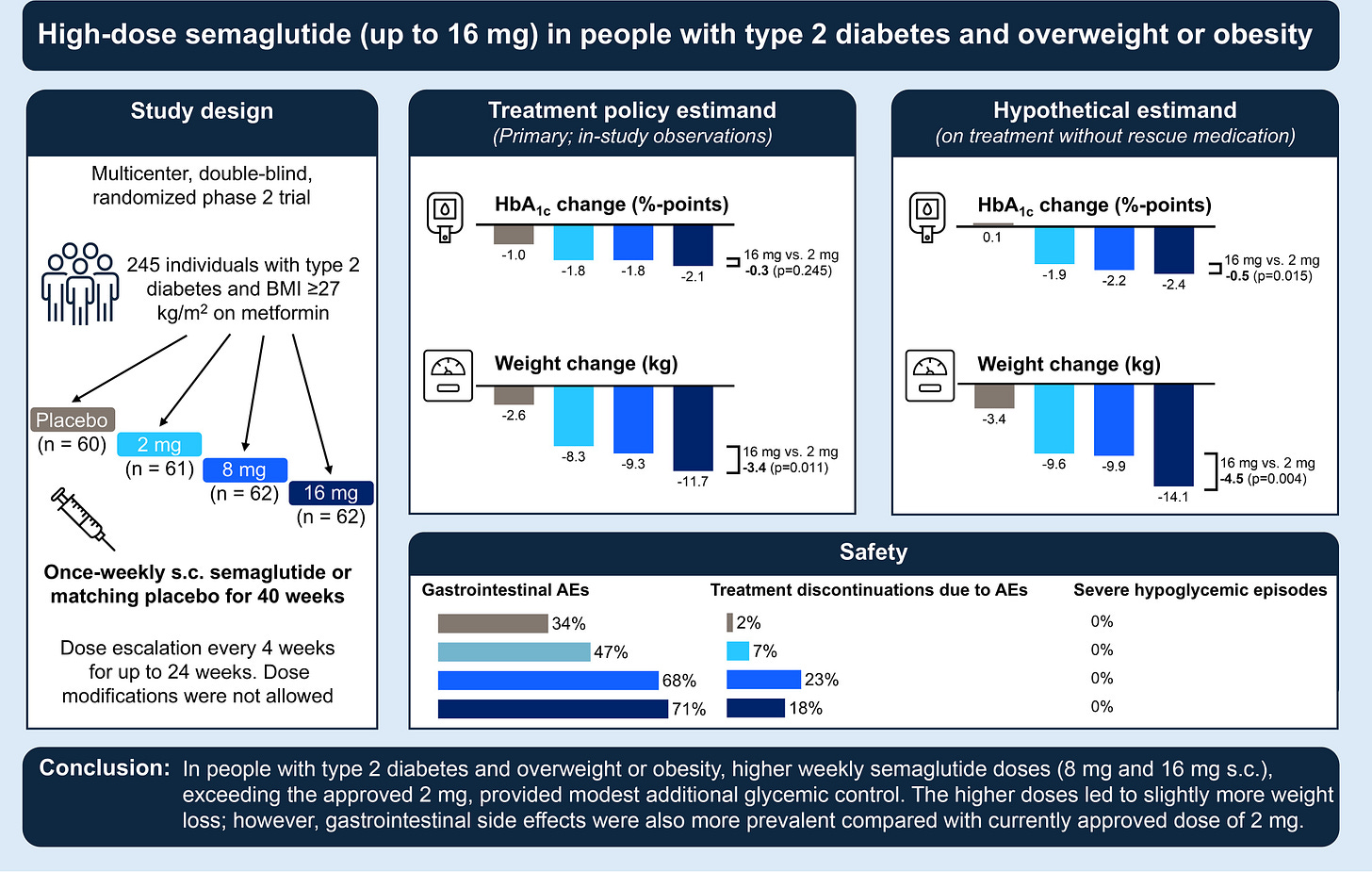Slowly but surely we are getting to the bottom of these near fainting spells. I have been in the hospital now since Friday and have had the full work up on my heart. The good new right now is that they have found nothing remarkable about my heart as the potential cause for what is going on. This is a huge relief for me, but also raises more questions. For now, I’ll take the peace of mind that my heart has essentially been given a clean bill of health, and we have implemented a good medical strategy to keep it that way. Thank you for those who have helped keep us going even while I’m down. Consider joining as a paid subscriber today!
Now to the good stuff…
It feels like we have been talking about “microdosing” and “superdosing” a lot lately lately. “Personalized” obesity medicine is the hot button in marketing right now, and in the GLP-1 world, the race for higher and higher doses has been growing louder. Novo Nordisk is working on their 7.2 mg semaglutide for obesity, while some Compounding pharmacies have already begun to offer high-dose versions. The black market Reddit crowd has gone even higher, yet.
But a brand new phase 2 study just published in Diabetes Care drops some much needed reality on the table. And it matters because a lot of you in the OTP community are either being offered higher compounded doses or wondering if you should be pushing your doctor to go beyond 2 mg of Ozempic or 2.4 mg of Wegovy. So let’s unpack what this study data really tells us.
Researchers tested once weekly semaglutide at 2 mg, 8 mg, and 16 mg in people with type 2 diabetes and overweight or obesity. They wanted to know: Do the higher doses give us better blood sugar control? Do they drive more weight loss? And what about tolerability?
Here is the punchline. For glucose control, higher doses barely helped. The 16 mg dose dropped A1C only about 0.5 percentage points more than 2 mg. That’s an 800% increase in weekly semaglutide, for a pretty minimal payoff. And when you looked at all patients in the trial, that difference was even smaller and statistically insignificant. For improved A1c, not likely worth it.
For weight loss? Yes, higher doses did drive more loss. Patients on 16 mg lost about 4.5 kg (roughly 10 pounds) more than those on 2 mg. That part is real. But… it came with a cost. Side effects, especially gastrointestinal, shot way up. More people dropped out of the trial on higher doses. Nearly 30 percent of the high dose groups discontinued, compared to 15 percent on 2 mg. Dysesthesia (odd nerve sensations) also showed up, something not typically seen with subcutaneous semaglutide before.
In other words, pushing semaglutide to 8 or 16 mg may give you more weight loss, but it is not giving you vastly better diabetes control, and it may be much harder to tolerate. Some of you are nauseous just thinking about the current full doses of semaglutide.
The study authors conclude that for type 2 diabetes, there is no real justification for using doses higher than 2 mg for glycemic control. For obesity, the story is different, and more trials are coming there.
Now, why does this matter for us? Because out in the wild west of custom dosing right now, you see pharmacies and some clinics promoting high-dose semaglutide, and it’s important to look at what the data is telling us. If you are using semaglutide for type 2 alone, this trial suggests you should stick to 2 mg. There is little magical glycemic gain beyond that point. If your goal is purely weight loss, then sure, higher doses might help, but you are also really rolling the dice on tolerability.
That said, you know I’d be down to give it a try 😉
The bottom line here is important. Just because more is possible does not necessarily mean more is always better. And at these incredibly high doses, it may not even be worth the risk for many patients.
The STEP UP trial, which reported topline results early this year, showed that semaglutide 7.2 mg achieved an average 20.7 percent weight loss, outperforming the current 2.4 mg dose with a similar safety profile. That was in an obesity-focused trial. A sister trial, STEP UP T2D, is still underway to evaluate 7.2 mg in people with type 2 diabetes. That study will give us a much better sense of whether higher doses like 7.2 mg can safely deliver more meaningful weight loss for people managing both diabetes and obesity. But based on the data we have today from this new 16 mg trial, pushing semaglutide above 2 mg specifically for glycemic control is simply not supported.
If you are interested in exploring whether Ozempic, Wegovy or another GLP-1 might be right for you, there’s never been a better time to take a look at our podcast sponsor, Ro! Between their insurance checker tool, prior authorization expertise, and easy to use mobile app, getting care has never been more in reach!






So happy to hear your heart is well! Keep resting and letting the doctors figure this out. We want you back, but not until you’re healthy and not risking another episode. Good update on the Sema findings. Tirz is still going to be my go to. Take care and give my best to your wife. I’m sure she’s overwhelmed right now. We are praying for both of you!!
I’m happy to hear you are doing well and have a plan for your cardiac health.